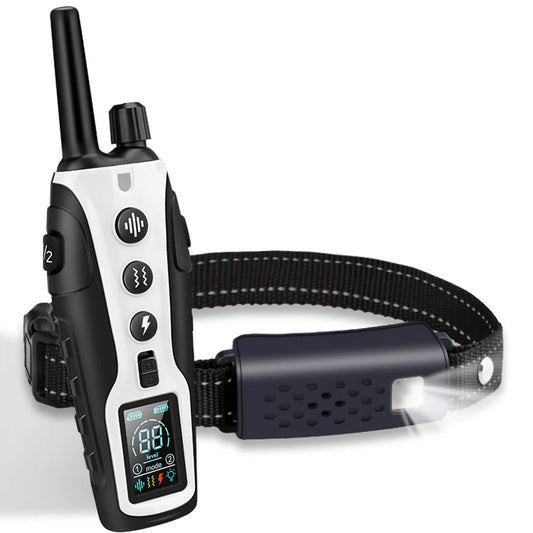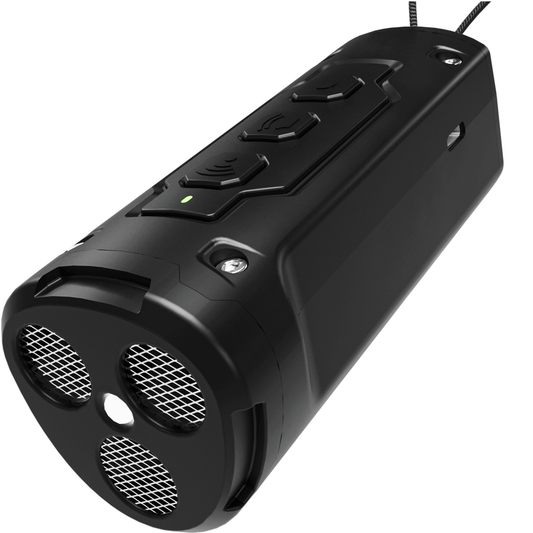How To Get Neighbors Dog To Stop Barking!
Dealing with a neighbor's barking dog can be frustrating and disruptive, especially if it's a chronic problem. While talking to your neighbor and addressing the issue directly may be the first step, there are other solutions to consider. One such solution is the use of an ultrasonic anti-barking device.
Ultrasonic anti-barking devices work by emitting a high-pitched sound that is unpleasant to dogs but inaudible to humans. These devices can be used indoors or outdoors and are often small and discreet. They can be effective in interrupting a dog's barking and can be an alternative to more invasive methods like citronella collars or shock collars.
When using an ultrasonic anti-barking device to address a neighbor's barking dog, it's important to position the device so that it is directed towards the dog and not towards other neighboring dogs or animals. Additionally, it's crucial to use the device consistently and in conjunction with other training methods, such as positive reinforcement training.
It's also important to note that ultrasonic anti-barking devices are not a guaranteed solution and may not work for all dogs. Some dogs may become habituated to the sound or may not be bothered by it at all. In these cases, it may be necessary to consider other solutions or seek the help of a professional dog trainer or behaviorist.
Ultimately, if you are dealing with a neighbor's barking dog, it's important to approach the situation with empathy and understanding. While an ultrasonic anti-barking device may provide some relief, it's important to also consider the root causes of the dog's barking and work towards a solution that addresses those issues. With patience and persistence, it is possible to find a peaceful resolution that benefits both you and your neighbor's dog.
Understanding how stop barking device & ultrasonic anti-barking devices work:
Barking is a common behavior for dogs, but excessive barking can be a nuisance, especially for neighbors. If you have tried different approaches to stop your neighbor's dog from barking, such as talking to the owner, providing the dog with enough exercise and mental stimulation, and positive reinforcement training, but nothing seems to work, an ultrasonic anti-barking device may be a solution.
Ultrasonic anti-barking devices are a humane and safe way to discourage excessive barking behavior in dogs. They emit a high-frequency sound that is unpleasant to dogs but inaudible to humans. When the dog barks, the device detects the sound and emits the ultrasonic sound, which interrupts the barking and encourages the dog to stop.
Using an ultrasonic anti-barking device has several advantages. First, it is a non-invasive way to control excessive barking behavior. The device doesn't cause any physical harm to the dog, and it doesn't require any special training or skills to use. Second, it can be effective in deterring barking behavior in most dogs, especially if used consistently and correctly.
When using an ultrasonic anti-barking device, it's essential to consider the distance and placement of the device. The device should be placed in a location where it can easily detect the barking sound, and the sound can reach the dog. The device should also be placed in a way that doesn't block the dog's movement or access to food, water, and shelter.
Using the ultrasonic anti-barking device correctly. How To Stop Dog Barking
Positioning: The device should be positioned in a strategic location that is close enough to the dog to pick up the barking, but not so close that the dog can touch or chew the device. It's best to place the device in a location where it has a clear line of sight to the dog, such as a nearby tree or fence.
Consistency: To see the best results, the device should be used consistently every time the dog barks. This means leaving the device turned on and within range of the dog, even when you're not home. This can help reinforce the association between barking and the unpleasant ultrasonic sound.
Timing: It's important to use the device at the right time. For example, if the dog is barking due to fear or anxiety, using the device may not be effective as it may further increase their anxiety. In these cases, it may be more appropriate to address the underlying cause of the barking behavior.
Sensitivity: Some ultrasonic anti-barking devices have adjustable sensitivity levels. It's important to adjust the sensitivity level to match the dog's bark intensity, as setting it too high or too low may not be effective in stopping the barking.
Battery life: It's important to keep the device charged or replace the batteries as needed to ensure it's always working properly.
By following these tips, dog owners can effectively use ultrasonic anti-barking devices to address excessive barking behavior in their pets. However, it's important to remember that these devices should not be the sole solution and should be used in conjunction with positive reinforcement training and other techniques to address the underlying cause of the barking behavior.
Working with your neighbor:
If you're dealing with a neighbor's barking dog, it can be a frustrating and stressful situation. While using an ultrasonic anti-barking device can be effective, it's also important to consider working with your neighbor to address the issue. Here are some tips for how to approach this conversation:
Be polite and respectful: Start the conversation by introducing yourself and expressing your concern about the barking dog. Avoid using accusatory language or making assumptions about your neighbor's intentions.
Offer potential solutions: Instead of just complaining about the problem, come to the conversation with potential solutions. For example, you could suggest that your neighbor bring their dog inside at night or consider professional training.
Listen to their perspective: Your neighbor may have a different perspective on the situation, so it's important to listen to their concerns and be willing to compromise. For example, if they work long hours and can't always supervise their dog, you could offer to keep an eye on the dog during the day.
Follow up: After the conversation, follow up with your neighbor to see if the solution is working. If it's not, you can revisit the conversation and try to find a different approach.
In addition to working with your neighbor, using an ultrasonic anti-barking device can be a helpful tool in addressing the problem. By positioning the device in a strategic location and using it consistently, you can help discourage the dog from barking excessively.
Remember, addressing a neighbor's barking dog requires patience and understanding. By working together and using the right tools, you can find a solution that works for everyone involved.
Additional measures to stop the barking with anti dog barking device:
While an ultrasonic anti-barking device can be an effective tool, it may not work for all dogs or situations. It may be necessary to use additional measures, such as providing the dog with more exercise and mental stimulation, or contacting local authorities if the barking persists.
An incessantly barking dog can be a source of frustration and stress, not only for the owners but also for the neighbors. While an ultrasonic anti-barking device can be a useful tool to deter the behavior, it may not be effective in all situations. In such cases, it may be necessary to take additional measures to address the issue.
One such measure is to ensure that the dog is receiving adequate exercise and mental stimulation. Dogs that are bored or have pent-up energy are more likely to bark excessively, so providing them with plenty of exercise and playtime can help reduce the behavior. This can include daily walks, puzzle toys, and training sessions.
Another approach is to work with the owner of the barking dog to find a solution. Having a respectful and non-confrontational conversation about the issue can go a long way in addressing the problem. The owner may not be aware that their dog is causing a disturbance, and working together to find a solution can lead to a positive outcome for everyone involved.
If the barking behavior persists despite these efforts, it may be necessary to contact local authorities, such as animal control or the police. In some cases, excessive barking may be a violation of noise ordinances, and the authorities may be able to intervene to help address the issue.
In conclusion, while an ultrasonic anti-barking device can be a helpful tool, it is important to remember that it may not be a one-size-fits-all solution. Taking additional measures, such as providing exercise and mental stimulation, working with the owner, and contacting authorities if necessary, can help address excessive barking and restore peace to the neighborhood.
Real-life success stories of using anti-barking devices on neighbor's dogs or your dog
Anti-barking devices have become increasingly popular in recent years, and for good reason. They have been proven to be effective in controlling excessive barking in dogs, which can be a source of annoyance and disturbance for neighbors and owners alike. Here are a few real-life success stories of using anti-barking devices on neighbor's dogs or your dog:
One neighbor had a dog that barked constantly throughout the day and night, causing a great deal of frustration for those living nearby. After trying various methods to stop the barking with no success, they decided to invest in an ultrasonic anti-barking device. The results were almost immediate, with the dog responding well to the device and significantly reducing its barking. The neighbor was pleased with the device's effectiveness and grateful for the peace and quiet it brought to the neighborhood.
A dog owner was struggling with their own dog's barking, which was becoming excessive and causing tension in their home. They tried various training techniques but were unable to control the behavior. They decided to try a spray bark collar, which releases a burst of citronella spray when the dog barks. The collar worked wonders, and the dog quickly learned to associate barking with the unpleasant spray. The owner was pleased with the collar's effectiveness and was happy to have found a solution to their dog's barking.
Another neighbor was struggling with a group of dogs in their area that would bark at all hours of the night. They tried talking to the owners but were met with resistance and no change in the dogs' behavior. They then invested in an outdoor ultrasonic anti-barking device, which emits a high-pitched sound that dogs can hear but humans cannot. The device worked well, and the dogs quickly learned to associate the unpleasant sound with barking. The neighbor was pleased with the device's effectiveness and happy to finally have some peace and quiet at night.
These real-life success stories demonstrate the effectiveness of anti-barking devices in controlling excessive barking in dogs. Whether it's a neighbor's dog or your own, investing in an anti-barking device can be a simple and effective solution to a common problem.
Also, you can see our social media:




